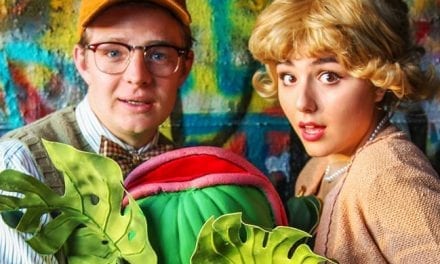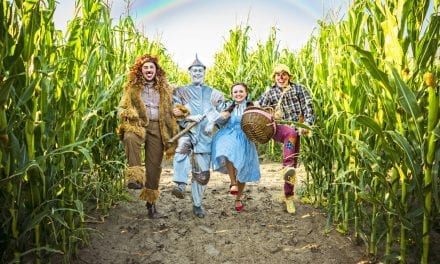SALT LAKE CITY — Animal Farm, based on George Orwell’s 1945 novella of the same name, spins a fable inspired by the Russian revolution of 1917 and its descent into Stalinism. From a contemporary vantage point, however, the tale easily transcends its original context to serve as a satirical critique of human nature and the development of authoritarian systems of control, whatever their ideological underpinnings. The University of Utah’s thoughtful, pessimistic production at the Babcock Theatre, directed by Jamie Rocha Allan, privileges this more universal interpretation by using masks to characterize not just the animals, but the humans as well.
Set on a farm in rural England, the plot centers around an animal revolt and the expulsion of their human oppressors. Led chiefly by the pigs Snowball (Kate Lanphier) and Napoleon (Cody V. Thompson), the animals soon establish their own regime around the principles of “animalism” and agree on a body of laws that boils down to “four legs good, two legs bad.” However, as their egalitarian organization begins to decay, one is tempted to conclude that the animals have been perverted by the human patterns of behavior they begin to emulate.
Yet, the production’s use of human masks suggests a subtle, but crucial, difference of interpretation. The masks put the people on the same level as the beasts — portraying them as just another animal species. This transforms the contours of the story from those of lost innocence to an exposé of the baser, animalistic impulses latent in our souls, biding their time for the opportunity to strike. In other words, the animals have not fallen to become like the humans; rather, humans are simply no better than animals in the first place.
Such a premise naturally makes the costume design the most conspicuous technical aspect of the production. Moreover, Animal Farm raises the level of difficulty even higher since the plot requires — without giving anything away — that the guiding tenet of animalism, “four legs good, two legs bad,” be rendered literally. The conceptual design of the animals, therefore, needs to enable the actors to operate on four legs, which precludes more minimalist options.
To achieve this, designer Sarah Rogers has fitted the actors with hand crutches ending in hooves or paws, depending on the animal, whose exterior covering extends up over the actors’ arms to their shoulders, obscuring their hands and giving the impression of lengthy forelegs. These are not just for show. As the actors walk and stand, they lean forward at about a thirty-degree angle, using these limb extensions for support. It is a workable solution, but the results vary. For example, the long forelegs suit the horses and dogs much better than the pigs. In fact, the lovely exhibit in the foyer, which showcases the design and realization of the costumes and masks, includes conceptual drawings of shorter legs. This might have been more visually appealing for the pigs, though perhaps more uncomfortable for the actors, as it would have required a more hunched-over posture.
Brenda Van der Wiel’s molded masks (made with special assistance by Holly Cole) all feature unique enough characteristics and flashes of personality to make it easy to tell animals of the same species apart (an important distinction for the various pigs). To be more precise, the majority are not quite masks, but more like angled hats, mounted on the actors’ heads so that, when they lean forward on their front legs and look downward, the animal faces point forward.
At first, the combination of gangly legs and hat-masks was distracting. The legs and hooves produced loud, heavy thuds as they clomped around the stage. While this contributed to an overall atmosphere of herd chaos, it was also an occasional obstacle to the actors’ projection, especially with their mouths pointing at the floor. In the beginning, at least, I kept mentally willing the actors to raise their heads so I could get a better look at their faces.
However, the noisy hooves faded into the background as the play moved forward, perhaps due to heightened awareness and control on the actors’ part, perhaps because I was able to tune out the noise once I became accustomed to it. More importantly, though, it also became progressively easier to take the animal masks at face value. Again, this was partially a result of getting used to the concept, but it was aided by the excellent physicality of several of the principal actors. Their careful attention to the details of the orientation and movements of their bodies and heads succeeded in projecting the focus of their performances to the animal faces on their hats, instead of down to the floor of the stage.
Unfortunately, Ian Wooldridge’s adaptation does nothing to speed up the suspension of disbelief. The first half of the script groans under the weight of tedious exposition. It begins with a lengthy, visionary monologue from the aging pig patriarch, Old Major (John DeMonja), and then proceeds to string together scenes of meeting after meeting, interspersed with explanatory material provided by a trio of animal narrators (Kathryn Mungin, Mary E. Palmer, and Jasmin Peterson). This makes for a very talky first act, and when one character lamented the advent of yet “another meeting,” so did I. Still, this gradually gives way to more character-driven substance at about the same rate that the creatures come alive, as the horses Boxer (Josh Joles) and Clover (Bailey Walker), the donkey Benjamin (Glenn Brainerd), and the pig Squealer (Erica Carvalho) take a more central role.
The performances were consistently good (with the occasional shaky accent) and absolutely committed — which is fundamental to a play that calls for the actors to spend a lot of time making animal sounds. The scenes between Joles’s Boxer, Walker’s Clover, and Brainerd’s Benjamin, as they work through the tension between their memories of the revolution and the slippery commandments painted on the barn wall, provided the pathos missing from the first half of the show. And Carvalho’s Squealer, as the regime’s propaganda guru, was the highlight of the evening. She nearly convinced me that I was misremembering the clunky talkiness of the beginning with her smooth verbal manipulation and Dolores Umbridge-worthy wiggle of delight at each newly spun political maneuver.
Though Animal Farm has its share of weaknesses, they are front heavy, and the balance favors its successes by the end. Nevertheless, it reaches a sobering conclusion about humanity that not only underscores the symbolism of the interplay between the human and animal masks, but also functions as a bookend to the visual impact of the striking pre-curtain harbinger of doom displayed in the upstage center of the barnyard: a slaughtered human torso, strung up like the carcass of an animal.






